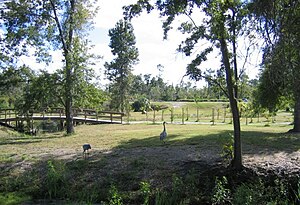Arboretum of the University of Central Florida
| Arboretum of the University of Central Florida | |
|---|---|
 Arboretum of the University of Central Florida | |
| Location | Orange County, Florida |
| Coordinates | 28°36′14″N 81°11′35″W / 28.60381°N 81.193°W |
| Area | 80 acres (32 ha) |
| Created | 1983 |
| Operated by | University of Central Florida |
The Arboretum of the University of Central Florida is located on the main campus of the University of Central Florida in Orlando, Florida, United States. Covering 80 acres (320,000 m2), it contains more than 600 species of plants, including more than 100 bromeliads, in cultivated gardens.
History
[edit]Established by President Trevor Colbourn in 1983, The Arboretum began with approximately 12 acres (49,000 m2) of a disturbed pond pine community on the east side of the developed part of campus, east of the present biology building. In 1988, at President Altman’s direction, the University expanded the Arboretum to include a 5-acre (20,000 m2) Cypress dome, an oak hammock of about 3 acres (12,000 m2), and about 15 acres (61,000 m2) of sand pine and Florida scrub, connected to the original Arboretum by Sabal palmetto community and increasingly rare Florida longleaf pine flatwoods. During this time the director of the Arboretum was Dr. Henry O. Whittier. He would remain director of the Arboretum until his retirement in 2003, when Dr. Whittier was replaced as director by Dr. Martin Quigley, who served as director until 2009. In 2009, the Arboretum established a 0.15-ha organic community garden. In 2010, Dr. Patrick Bohlen was hired as the Director of Landscape and Natural Resources and Arboretum.
Natural areas
[edit]East of Orlando, and about five miles (8 km) north of State Route 50 on Alafaya Trail, The University of Central Florida occupies approximately 1,100 acres (4.5 km2) of east central Florida natural habitats, including some of the last elevated land (about 75 feet (23 m) above sea level) before the St. Johns River, which lies between the campus and the coast. Elevations range from about 50 feet (15 m) to 75 feet (23 m) above sea level, and more than two thirds of the campus has been described as wetlands, under the protection of the St. Johns River Water Management District. The northeast and southeast sections of campus are wetland preserves whose waters flow east and north into the little Econlockhatchee River, which in turn flows into the Big Econlockhatchee before it joins with the St. Johns River near State Highway 46.
The elevated northwest corner of campus is geologically ancient coastline ridge which, because of its excellent water drainage, includes nature preserve containing a small remnant of the easternmost longleaf pine and American turkey oak association in central Florida. Most of the American turkey oak has disappeared from the highest part of the ridge, occupied by Alafaya trail. Intermittent or Shallow ponds and a small 5-acre (20,000 m2) lake, Lake Claire, lie immediately to the east. A small beach and some picnic pavilions are maintained for campus recreation.
On the east side of campus, east of Gemini blvd and south of Orion blvd, lies a 5-acre (20,000 m2) Cypress dome, an oak hammock of about 3 acres (12,000 m2), about 15 acres (61,000 m2) of sand pine and wild rosemary scrub, and 32 acres (130,000 m2) of pine flatwoods.
Wild rosemary scrub and longleaf pine flatwoods habitats are eminently suitable for construction, but the great majority of Florida endemic (unique) species are found in these habitats. The presence of these habitats within the Arboretum provides important opportunities for the introduction and preservation of threatened or endangered species.
The flatwoods are so flat that after heavy rains in may take water one or two days to drain off – so flat that the land slopes at a rate of not much more than 2-3 inches per mile! The vegetation may look pretty boring from the highway, but that’s because of the repetitiveness of widely spaced longleaf pines and the apparent continuity of the saw palmetto and occasional shrubby oaks, lyonias, and hollies. On foot, walking the narrow trails through this habitat in different months of the year, the person taking the time for a closer look sees a wide variety of more seasonal plants which includes wild orchids, pitcher plants, sundews, bladderworts, lobelias, mints, tar flowers, blueberries, and others.
To maintain this biodiversity, the flatwoods and scrub ecosystems require fire to help clean up the dead and dried-up plant material that after some time can completely cover the ground. When these materials are burnt they return their nutrients back into the ground as ash and the next generation of flowers and grasses can emerge and thrive. This is the continuous cycle of growth, fire, and regeneration that these ecosystems need to be healthy.
Recreation
[edit]The Arboretum currently has approximately 3 miles (4.8 km) of walking/biking trails through the scrub and longleaf communities. The Natural Areas are open to the public from sunrise to sunset, 7 days a week, 365 days a year. Pets are allowed as long as they are kept under control and on a 6-foot (1.8 m) leash. Group tours are available by reservation. Volunteer opportunities are also available with more information available at the website.
See also
[edit]External links
[edit]- Arboretum official website

